The M33 helmet (more formally, Elmetto Mod.33) was the standard helmet of the Italian army during WWII. It was designed in the early 1930s to replace WWI-era helmets. Made of 1.1mm heat-treated steel, the M33 was said to offer triple the protection of the French army’s then-current Adrian helmet (Italy expected France to be it’s enemy in any future war). All in all, the M33 was effective, comfortable, and economical for Italy to manufacture during WWII. It was a quality helmet.
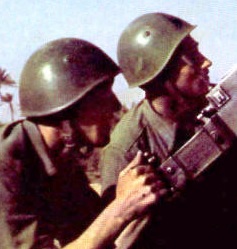 (Italian troops in WWII wearing the M33 helmet.)
(Italian troops in WWII wearing the M33 helmet.)
Unlike Germany’s M40 stahlhelm or Japan’s M30-32 Tetsu-bo, the Italian M33 had a generic, nondescript shape and thus it carried no “political baggage” after WWII ended in 1945. It went on to have a long postwar career with the new Italian army, and also saw some overseas usage after WWII.
(Italian army 1970s-vintage camouflage cover and foilage net on a M33.)
POST-WWII USAGE OF THE M33
Italy
When Italy joined the Allied side in 1943, the M33 was obviously still the main helmet of the new Co-Belligerent Forces. In 1944-1945, the British attempted to replace the M33 with the Mk.II Tommy helmet; however only two divisions had switched by the time the war ended. Meanwhile the US Army transferred some M1 pot helmets as well, but not enough to completely re-equip any large units.
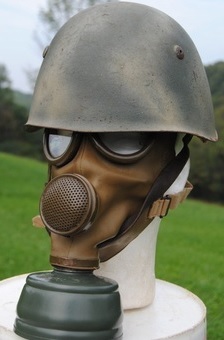 (The M33 helmet and M31/34 gas mask,which was the standard Italian issue gas mask during WWII and then after the war into the late 1940s.)
(The M33 helmet and M31/34 gas mask,which was the standard Italian issue gas mask during WWII and then after the war into the late 1940s.)
(The M33 helmet and Italy’s modern Pirelli gas mask with chemical warfare suit, probably during the 1970s.)
After the end of the war in 1945, the Italian army gave some thought to abandoning the fascist-era M33 in favor of either the American M1 or British Mk.II Tommy. However the war in the Pacific was still going on, and the USA was unable to provide the required quantity of M1s. Meanwhile the Tommy was absolutely hated by Italian soldiers, and to a lesser extent, by the Italian public who saw it as a symbol of their army being reduced to second-rate status.
After some thought it was decided to retain the M33 and the Tommy helmets were gradually phased out.
The M33 remained the standard Italian army helmet through the end of the 1980s. During the Cold War, production was restarted. Postwar-manufactured examples are nearly identical bit have a slightly different interior headband, a different serial number scheme, and have a canvas chinstrap replacing the leather one of the 1930s and 1940s.
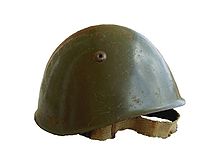 (An Italian army M33 of the 1960s/1970s era. After WWII a more durable paint was used, and the leather chinstrap was replaced by a fabric one.)
(An Italian army M33 of the 1960s/1970s era. After WWII a more durable paint was used, and the leather chinstrap was replaced by a fabric one.)
The old Italian army tradition of helmet plumes was retained and a device was issued so that these could continue to be fitted to M33s during the Cold War.
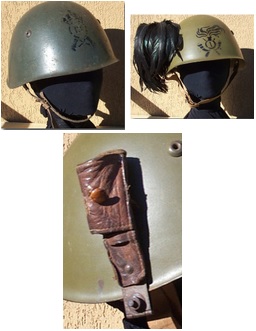 (An Italian army M33 without and with the feather plume, and the device to mount it.) (official Italian army photos)
(An Italian army M33 without and with the feather plume, and the device to mount it.) (official Italian army photos)
The postwar Italian navy also retained the M33. It was used ashore for security details, commando units, and aboard warships for gun crews and bridge staff when the vessel was at battlestations. There was also a special naval version of the M33 with huge cut-out sections on either side, so that Italian sailors could use sound-powered phones found on American-supplied warships after WWII. The Italian navy retained the M33 until 1979.
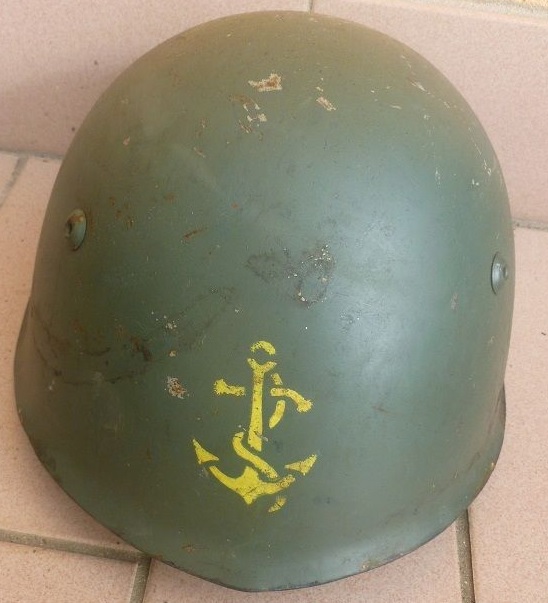 (A Cold War-era Italian navy M33.)
(A Cold War-era Italian navy M33.)
The Italian military published a user’s guide for the M33 in the 1950s. It laid out the proper wear and decorations, and warned Italian soldiers not to use the M33 as a cooking bowl, due to intense heat drawing out the steel’s temper and making the helmet likely to crack or shatter upon a severe impact. It should be noted that while the M1 pot helmet was in US Army service, it was often misused for the same purpose and the US Army issued a strong warning not to, for the same reason.
In the 1990s, Italy began phasing in kevlar helmets and the M33 was relegated to niche, specialty, or second-line units.
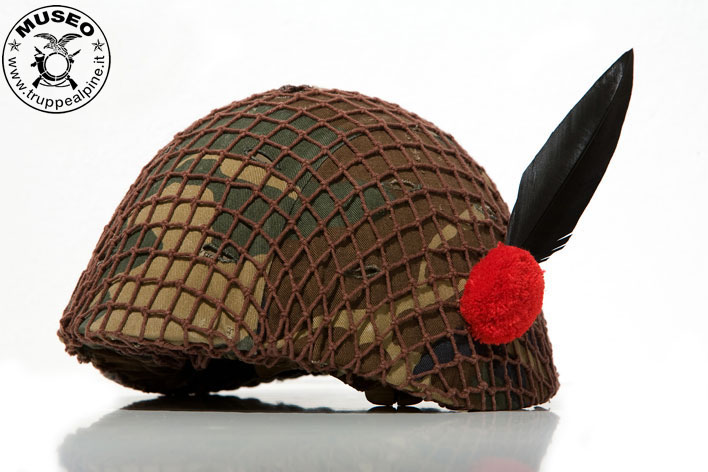 (The Italian Alpine Troops were one of the last major users of the M33 in Italy, retaining them until the turn of the millennium. This photo shows the post-WWII camouflage cover and foilage net, plus the red cockade with feather of the mountain soldiers.) (photo from Alpine Troop Museum)
(The Italian Alpine Troops were one of the last major users of the M33 in Italy, retaining them until the turn of the millennium. This photo shows the post-WWII camouflage cover and foilage net, plus the red cockade with feather of the mountain soldiers.) (photo from Alpine Troop Museum)
The last user overall in Italy was the national forest service, which finally retired the M33 in 2014.
Albania
Albania’s use of the M33 is most interesting, as the helmet had two separate “tours of duty” in the country. When Albania was an Italian vassal between 1939-1943, it’s small puppet army was partially equipped with M33s. These continued in use when the communists took over in 1945, at the same time Soviet-made helmets began to replace them. Some M33s were still in use at the start of the 1950s, and the helmet was officially relegated to reserve warehouses at the end of 1952. Later during the Cold War, Chinese-made helmets replaced the WWII-era Soviet ones, which in turn displaced the M33s from warehouses for scrapping.
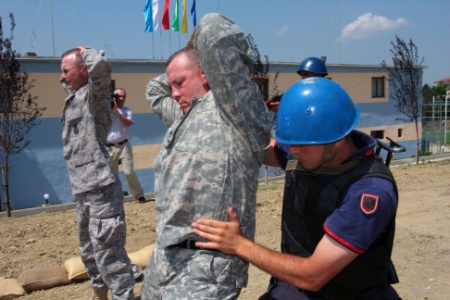 (An Albanian army MP in 2009 wearing a M33. The “suspects” are instructors from a joint US Army / US Air Force security specialist team, providing intra-NATO military police training for the Albanians.) (official US Army photo)
(An Albanian army MP in 2009 wearing a M33. The “suspects” are instructors from a joint US Army / US Air Force security specialist team, providing intra-NATO military police training for the Albanians.) (official US Army photo)
Communism collapsed in Albania in 1992. This was followed by a period of chaos, during which the already-backwards Albanian army fell into near complete disorder. In 1997, Italy led a multinational force into the country to restore order and help rebuild the military to western form, as part of Albania’s goal of NATO membership (which it achieved in 2009). As part of the effort, a quantity of warehoused M33s were donated to the Albanian army. So once again, the M33 became Albania’s battle helmet, until it began to be phased out again after NATO military aid became available in the 2010s.
Argentina
The Argentine army imported a small number of M33s during the late 1930s. They were not as popular as stahlhelms in Argentina, and only served a short while after WWII.
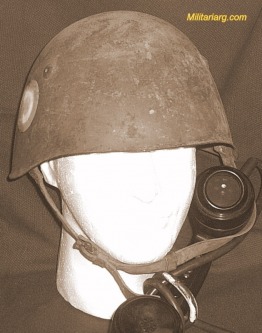 (Argentine army M33 of the 1940s, showing how carabiners could be used in conjunction with the leather chinstrap for a “hands-free” field phone.) (photo from militariarg.com website)
(Argentine army M33 of the 1940s, showing how carabiners could be used in conjunction with the leather chinstrap for a “hands-free” field phone.) (photo from militariarg.com website)
Bosnia-Herzegovina
Surprisingly, a handful of WWII-vinage M33s were found in use by the Bosniak muslim forces during the 1990s conflict there. These were almost certainly ex-Yugoslav (see below sections) and due to their small number, may have been museum loots.
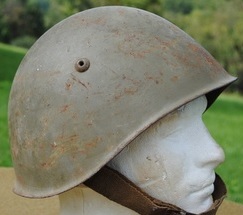 (A rusty M33 as used by a muslim fighter in Bosnia during the 1990s; later brought back as a souvenir by an international peacekeeper.)
(A rusty M33 as used by a muslim fighter in Bosnia during the 1990s; later brought back as a souvenir by an international peacekeeper.)
Ecuador
The army of Ecuador made a large buy of Italian helmets in 1938. Some were old surplus M15s (which the M33 replaced in Italian service) but more were new-production M33s. Ecuador fought a brief, one-month war against Peru in July 1941 (known as Guerra del 41 in both countries, and largely ignored elsewhere) which resulted in an Ecuadorian defeat. Ecuador’s forces were very poorly organized and many went into battle not having received their M33s, however, invading Peruvian troops captured a stockpile of them in an armory. Because of the loss, and the now-possibility of friendly fire mistakes in any future war against Peru, the Ecuadorian army phased out the M33 in the early 1940s and replaced it with American-made M1 pot helmets obtained as WWII military aid.
Peru
The Peruvian army imported M33s in the late 1930s, replacing WWI-era French helmets previously used. It’s M33 supply was then bolstered by examples captured from Ecuador in July 1941. Peru continued to use the M33 until 1956.
(A Peruvian army air corps motorcycle soldier with M33; his companion has a French-designed helmet designated “M34” by the Peruvians; it was a copy of the French Mle.26 Adrian and called “the sun god” because of it’s sun-shaped crest.)
Spain
Mussolini provided a quantity of M33s to Franco’s civil war troops, with deliveries starting in 1938. While the M33 was never the “main” Spanish helmet type, a significant number were imported and served on long after WWII ended. As Spain remained neutral in the war, none were lost.
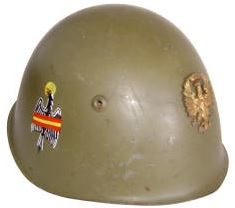 (For some time, Spain applied national colors decals on the sides of it’s M33 helmets, in the Wehrmacht style. This was generally discontinued in the 1950s.)
(For some time, Spain applied national colors decals on the sides of it’s M33 helmets, in the Wehrmacht style. This was generally discontinued in the 1950s.)
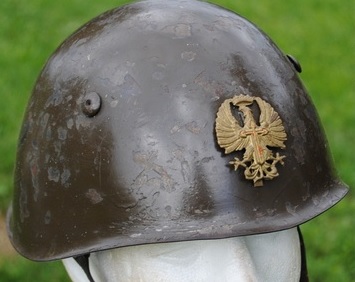 (A Spanish army M33 with the standard 55mm Cruz Santiago badge. Spanish army M33s used two colors after WWII; the original OD green as delivered from the Italian factory and later, the much darker, blackish-green seen above.)
(A Spanish army M33 with the standard 55mm Cruz Santiago badge. Spanish army M33s used two colors after WWII; the original OD green as delivered from the Italian factory and later, the much darker, blackish-green seen above.)
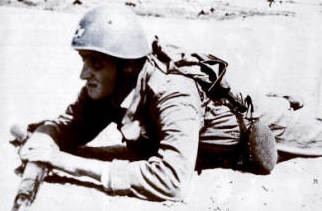 (King Juan Carlos I wearing a M33 in the 1950s during his military service as a young man, when he was still crown prince.)
(King Juan Carlos I wearing a M33 in the 1950s during his military service as a young man, when he was still crown prince.)
The Spanish air force also used the M33. Their examples were painted haze grey and had Spanish air force wings painted on the front instead of the Cruz Santiago badge.
In the post-WWII era, the M33 was still fairly common in Spanish service into the late 1950s. During the 1960s it was progressively withdrawn from use. Few were camouflaged although units serving in Spanish Sahara sometimes repainted theirs desert beige.
The M33 was withdrawn from large-scale Spanish use in the 1960s. By the early 1970s, only niche users in the Spanish military were still using it. By the time of Franco’s death in 1975, the only user was the Spanish Air Force Academy, which issued them to cadets until 1978.
Yugoslavia
The JNA (Yugoslav Federal Army) used M33 helmets in the immediate post-WWII period, along with British, German, and Soviet helmets. These M33s were obtained from a number of sources. Some were captured during the war by partisans fighting Italian troops in what is today Kosovo and Macedonia, others were left behind when the Italians evacuated Dalmatia and Trieste at the end of the war. The Yugoslavs phased the M33 out in the early 1950s.


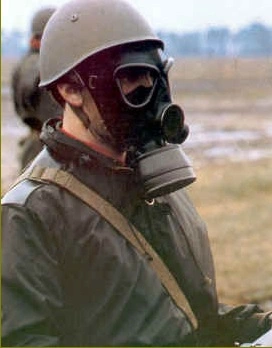
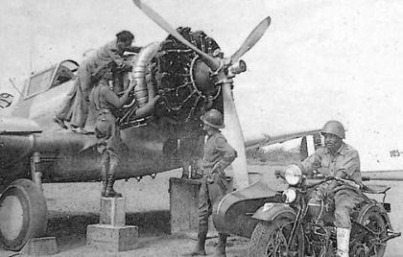
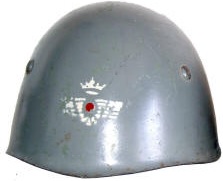
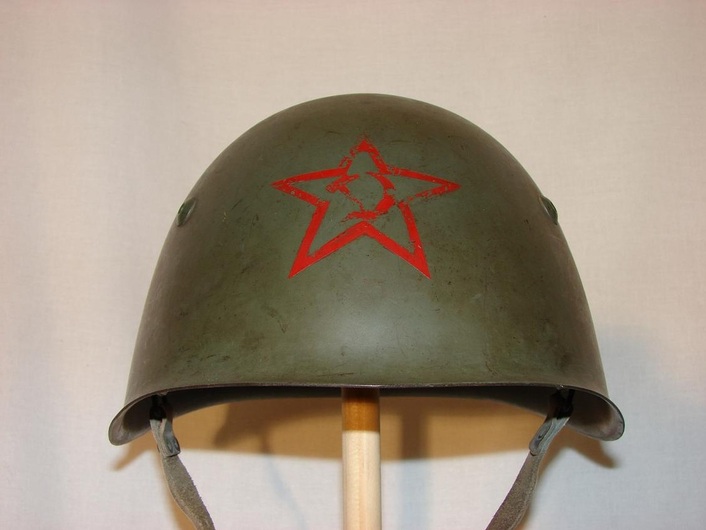
Italy did use SMLEs, Bren Guns and Thompsons for some time after the war, however the longest serving weapons were the M1 Carbine (in the Carabinieri corps) the M1 Garand (domestically produced by Beretta also), the Beretta 34 pistol, the MAB 1938 submachine gun (into the 1970s), the Breda-SAFAT and, believe it or not, the Carcano rifle (until 1981). MG42s are still in use.
LikeLiked by 1 person
I used the M33 steel helmet during my Italian military service in 1997/98. I was issued a post-war version with a canvas chinstrap, but there were still older versions with leather chinstraps, some probably WW2 refurbished helmets.
LikeLiked by 1 person
Albania also used the M33 in the 1950s, the country had been annexed by Italy in 1939 and after 1943 Italian military equipment was taken over by the Albanian resistance fighters who formed the basis of the new post-war Albanian army.
LikeLiked by 1 person
BTW Albania and Lebanon are still using the M33 since they acquired surplus stocks as Italy moved on to Kevlar helmets.
LikeLiked by 1 person
I believe I saw mixed piles of M33 helmets in Asmara, Eritrea after the civil war ended (1994/95), but maybe they were Bulgarian. I definitely did see other surplus Italian gear, mixed in with other surplus gear that the Eritreans had thrown into large piles here and there.
LikeLiked by 1 person
Bulgaria doesn’t even get an honourable mention? </3
LikeLike
I didnt know they used them in any great numbers?
LikeLike
The Bulgarian steel helmet for the majority of the cold war was a clone of the M33, the only notable differences were the flattened rivets, though some with Italian style rounded ones were either manufactured or otherwise acquired.
They actually even developed a new helmet based on the m33 (M72 helmet) which was still mostly just an M33, but with a more SSH40 shape along the edges. Curiously, the rounded m33 style rivets also reappeared for the m72.
LikeLiked by 1 person